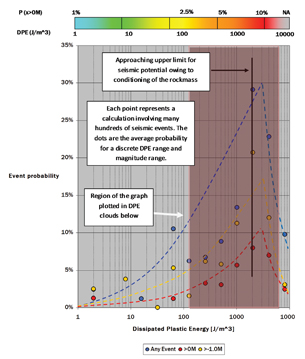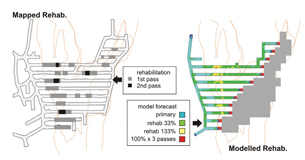Abaqus Accelerates Safety Sims in Mines with FEA
Realistic 3D simulations of mines developed with FEA help mining company achieve significant productivity gains.
Latest News
March 2, 2009
By Barry Oosthuizen
 Figure1: Simulated seismogenic zone above a developing deepmine cave, shown by calibrated Dissipated Plastic Energy. Figure1: Simulated seismogenic zone above a developing deepmine cave, shown by calibrated Dissipated Plastic Energy. |
In a step change beyond traditional processes, Abaqus finite element analysis (FEA) software from SIMULIA (the Dassault Systèmes’ brand for realistic simulation), is being used to enhance mine design and engineering simulation at a number of major mines around the world. In North and South America, Africa, and Australia some of the world’s biggest mining companies are applying FEA technology to evaluate safety and improve design planning, implementation, and operations.
Beck Arndt Engineering (BAE), a Sydney- based international consultancy, is a pioneer in the commercial development of engineering solutions for the mining industry. The consultancy has worked closely with engineers at SIMULIA Australia to expand the use of Abaqus FEA simulation software for mining applications.
Among the early adopters of mine-ready FEA technology is the world’s largest miner, BHP Billiton. With BAE’s help, BHP has already applied this technology to evaluate mines in Canada and Australia. At the BHP Billiton Nickel West Perseverance Deeps Project in Western Australia, Abaqus FEA software is now being used to help engineer the safety and productivity of planned deep-mining operations.
To achieve this goal in the deep-mining environment requires significant technological innovation. Using measurements of site deformation and seismic action, Abaqus FEA models have been calibrated and, in a single day, used to simulate a full, 3D, inelastic analysis of a mine’s life cycle.
In recent years, similar applications at Debswana’s Jwaneng Mine in Botswana, the Newcrest Mining Ridgeway Deeps Project in New South Wales, Australia, and Rio Tinto’s Argyle Diamond mine in Western Australia have also established Abaqus FEA analysis as the leading technology for multi scale, simulation-aided mining engineering.
The Abaqus Advantage
Joop Nagtegaal, Ph.D., a pioneer of FEA and a Dassault Systèmes Corporate Fellow, says that Abaqus FEA software is unique in its capabilities to enable mining engineers to investigate design innovations from the drawing board to full production.
“In the design stage,” says Nagtegaal, “Abaqus models, which include rockmass volumes spanning several kilometers around the ore body and down to excavations just a few meters across, are used to compare and optimize engineering options. Then, as the mine goes into production, large volumes of data ... are incorporated with the analysis models to allow them to be calibrated to a precision not previously available to the mining industry.”
Seismic event forecasting has become increasingly important at several sites where mining-induced seismic action is a concern. Stephan Arndt, Ph.D., a principal engineer at the BAE Perth office, said the vast amount of analysis required to create solutions in today’s competitive mining markets requires new technologies and methods.
One innovation has been the development of the dissipated plastic energy (DPE) analysis method. DPE analysis has been used to develop controls for potential problems, as well as to better understand how rock masses are damaged. (see Figure 1).
 Figure 2: Calibration of ground support performance. |
New Methods a Must
As the size and complexity of mining problems being studied increase, engineers are facing the need to leverage high-performance computing solutions.
“The size of the models we now use in mining is unprecedented,” says Arndt. “Distributed memory parallel (DMP) processing, using 32 CPUs with Abaqus FEA software, gives us the capacity to compare a number of different scenarios for minescale model simulations in a very short time. The level of detail achieved in these models allows us to calibrate deformation and rock-mass damage, seismogenic potential, and ground-support performance. Abaqus has an important role to play in mining and our analysis methods are setting new standards in this industry.” (see Figure 2).
Another application of nonlinear modeling is the design of ground support. Mine excavations are subject to high deformation. Not so typical are the strains and loads involved. In some mining cases, tunnels must survive in weak rock just a short distance from massive excavations at great depth.
“To ensure the safety of people and to achieve productivity objectives on these challenging sites with unique geological characteristics, mining engineers need to think outside the box,” says Arndt. “This technology enables quick, cost-efficient analyses,” which he says facilitate the logical decision-making necessary for the future development of mines in safe, environmentally-sound and more economical ways.
“Acceptance of FEA technology in mining is similar to the automotive industry experience,” says Nagtegaal. “Today, we are integrating Abaqus as a tool for simulation-aided mining engineering in much the same way, with similar achievements in cost-savings and improved safety.”
More Info:
SIMULIA
Providence, RI
Barry Oosthuizen is the communication advisor for SIMULIA. To comment, send e-mail to [email protected].
Subscribe to our FREE magazine, FREE email newsletters or both!
Latest News
About the Author
DE’s editors contribute news and new product announcements to Digital Engineering.
Press releases may be sent to them via [email protected].






